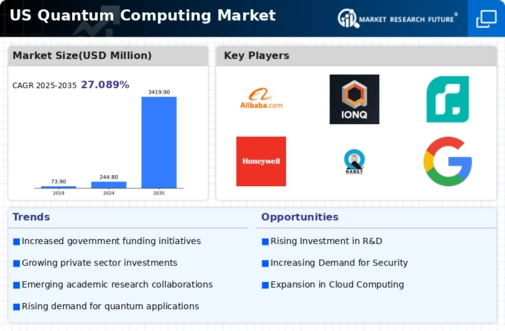Rising Government Support
The quantum computing market in the US is experiencing a surge in government support, which appears to be a crucial driver for its growth. Federal initiatives, such as the National Quantum Initiative Act, have allocated substantial funding to advance quantum research and development. In 2025, the US government is expected to invest over $1.2 billion in quantum technologies, fostering collaboration between public and private sectors. This financial backing not only enhances research capabilities but also encourages startups and established companies to innovate within the quantum computing market. The strategic focus on quantum technologies is likely to position the US as a leader in this field, potentially attracting international partnerships and investments.
Advancements in Quantum Hardware
Technological advancements in quantum hardware are significantly influencing the quantum computing market. Innovations in qubit design, error correction, and quantum processors are paving the way for more powerful and reliable quantum systems. In 2025, the market for quantum hardware is projected to reach approximately $5 billion, driven by the demand for enhanced computational capabilities. Companies are increasingly investing in developing superconducting qubits and trapped ion technologies, which are expected to improve the performance of quantum computers. As hardware becomes more accessible and efficient, the quantum computing market is likely to expand, enabling a broader range of applications across various industries.
Growing Interest from Enterprises
The quantum computing market is witnessing heightened interest from enterprises seeking to leverage quantum technologies for competitive advantage. Industries such as finance, pharmaceuticals, and logistics are exploring quantum computing for complex problem-solving and optimization tasks. In 2025, it is estimated that around 30% of Fortune 500 companies will have initiated pilot projects involving quantum computing. This trend indicates a shift towards integrating quantum solutions into business strategies, potentially transforming operations and decision-making processes. As enterprises recognize the potential of quantum computing, the market is likely to experience accelerated growth, driven by the demand for innovative solutions.
Increased Collaboration in Research
Collaboration among academic institutions, research organizations, and private companies is emerging as a vital driver in the quantum computing market. Partnerships are fostering knowledge exchange and accelerating the development of quantum technologies. In 2025, collaborative research initiatives are expected to account for nearly 40% of all quantum computing projects in the US. This collaborative environment not only enhances innovation but also helps in addressing the technical challenges associated with quantum computing. As more entities come together to share resources and expertise, the quantum computing market is likely to benefit from accelerated advancements and a more robust ecosystem.
Rising Demand for Quantum Software Solutions
The quantum computing market is increasingly driven by the rising demand for specialized quantum software solutions. As quantum hardware evolves, the need for software that can effectively harness its capabilities becomes paramount. In 2025, the quantum software market is projected to reach $1.5 billion, reflecting a growing recognition of the importance of software in maximizing quantum computing potential. Companies are investing in developing algorithms and applications tailored for quantum systems, which could lead to breakthroughs in various fields, including cryptography and machine learning. This trend suggests that as the quantum computing market matures, software development will play a critical role in its overall growth.























Leave a Comment